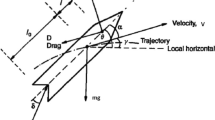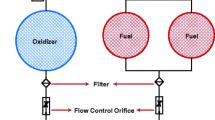Abstract
In the present paper, particle swarm optimization, a relatively new population based optimization technique, is applied to optimize the multidisciplinary design of a solid propellant launch vehicle. Propulsion, structure, aerodynamic (geometry) and three-degree of freedom trajectory simulation disciplines are used in an appropriate combination and minimum launch weight is considered as an objective function. In order to reduce the high computational cost and improve the performance of particle swarm optimization, an enhancement technique called fitness inheritance is proposed. Firstly, the conducted experiments over a set of benchmark functions demonstrate that the proposed method can preserve the quality of solutions while decreasing the computational cost considerably. Then, a comparison of the proposed algorithm against the original version of particle swarm optimization, sequential quadratic programming, and method of centers carried out over multidisciplinary design optimization of the design problem. The obtained results show a very good performance of the enhancement technique to find the global optimum with considerable decrease in number of function evaluations.






Similar content being viewed by others
References
Andre J, Siarry P, Dognon T (2001) An improvement of the standard genetic algorithm fighting premature convergence in continuous optimization. Adv Eng Softw 32:49–60
Baldur R (1972) Structural Optimization by Inscribed Hyperspheres. J Eng Mech ASCE 98(EM3):503–508
Balling RJ, Sobieszczanski-Sobieski J (1996) Optimization of coupled systems: a critical overview of approaches. AIAA J 34(1):6–17
Blair JC, Ryan RS, Schutzenhofer LA (2001) Launch vehicle design process: characterization, technical integration, and lessons learned, NASA/TP-2001-210992
Cramer EJ, Dennis JE, Frank PD, Lewis RM, Shubin GR (1994) Problem formulation for multidisciplinary design optimization. SIAM J Optim 4(4):754–776
Hammond WE (2001) Design methodologies for space transportation systems. AIAA, Reston
Hart C, Vlahopoulos N (2009) An integrated multidisciplinary particle swarm optimization approach to conceptual ship design. Struct Multidiscipl Optim 41(3):481–494
Holland JH (1992) Adaptation in natural and artificial systems. MIT, Cambridge
Isakowitz SJ (1995) International reference guide to space launch systems, 2nd edn. AIAA, Reston
Jodei J, Ebrahimi M, Roshanian J (2006) An automated approach to multidisciplinary system design optimization of small solid propellant launch vehicles. In: Proceeding of the 1st international symposium on systems and control in aerospace and astronautics, Harbin, China
Jodei J, Ebrahimi M, Roshanian J (2008) Multidisciplinary design optimization of a small solid propellant launch vehicle using system sensitivity analysis. Struct Multidiscipl Optim 38(1):93–100
Kennedy J, Eberhart RC (2001) Swarm intelligence. Morgan Kaufmann, San Francisco
Kirkpatrick S, Gellatt C, Vecchi M (1983) Optimization by simulated annealing. Science 220(4598):671–680
Peri D, Fasano G, Dessi D, Campana EF (2008) Global optimization algorithms in multidisciplinary design optimization. In: 2nd AIAA/ISSMO multidisciplinary analysis and optimization conference, Canada
Reyes-Sierra M, Coello Coello CA (2005) A study of fitness and approximation techniques for multi-objective particle swarm optimization. In: Congress on evolutionary computation, IEEE Service Center
Roshanian J, Jodei J, Mirshams M, Ebrahimi R, Mirzaei M (2010) Multilevel of fidelity multidisciplinary design optimization of small solid propellant launch vehicle. Trans Jpn Soc Astronaut Space Sci 53(179):73
Shi Y, Eberhart R (1998) A modified particle swarm optimizer. In: IEEE international conference on evolutionary computation. IEEE, Piscataway, pp 69–73
Smith RE, Dike BA, Stegmann SA (1995) Fitness inhertance in genetic algorithms. In: SAC’ 95: Proceeding of the 1995 ACM symposium on applied computing, Nashville, Tennessee, United States. ACM, New York, pp 345–350
Sobieszczanski-Sobieski J, Haftka RT (1997) Multidisciplinary aerospace design optimization: survey of recent developments. Struct Multidiscipl Optim 14(1):1–23
Tou JT, Gonzalez RC (1974) Pattern recognition principles. Addison-Wesley, Reading
Vanderplaats GN (2001) Numerical optimization techniques for engineering design, 3rd edn. Vanderplaats Research & Development, Colorado Springs. ISBN 0-944956-01-07
Venter G, Sobieszczanski-Sobieski J (2004) Multidisciplinary optimization of transport aircraft wing using particle swarm optimization. J Struct Multidisc Optim 26(1–2):121–131
Wertz JR (2000) Economic model of reusable vs. expendable launch vehicles. In: IAF 51st international astronautical congress Rio de Janeiro, Brazil
Wolpert DH, Macreadyt WG (1996) No free lunch theorem for search. Technical Report SFI-TR-95-02-010, Santa Fe Institute
Yao X, Liu Y, Lin GM (1999) Evolutionary programming made faster. IEEE Trans Evol Comput 3(2):82–102
Zhan Z-H, Xiao J, Zhang J, Chen W-N (2007) Adaptive control of acceleration coefficients for particle swarm optimization based on clustering analysis. In: Proceedings of the IEEE congress on evolutionary computation, Singapore, September 2007, pp 3276–3282
Author information
Authors and Affiliations
Corresponding author
Additional information
Multidisciplinary Design Optimization of a Small Solid Launch Vehicle which is the case study of the present manuscript has been previously published and presented in the below Journals and Confrences:
-
Roshanian J, Jodei J, Mirshams M, Ebrahimi R, and Mirzaei M (2010) Multilevel of Fidelity Multidisciplinary Design Optimization of Small Solid Propellant Launch Vehicle, Transaction of the Japan Society of Astronautical and Space Science, Vol. 53, No. 179.
-
Jodei J, Ebrahimi M, and Roshanian J (2008) Multidisciplinary design optimization of a small solid propellant launch vehicle using system sensitivity analysis, Structural and Multidisciplinary Optimization, 38(1): 93-100.
-
Jodei J, Ebrahimi M, and Roshanian J (2006) An Automated Approach to Multidisciplinary System Design Optimization of Small Solid Propellant Launch Vehicles, Proceeding of the 1st International symposium on Systems and Control in Aerospace and Astronautics, Harbin, China.
Rights and permissions
About this article
Cite this article
Ebrahimi, M., Farmani, M.R. & Roshanian, J. Multidisciplinary design of a small satellite launch vehicle using particle swarm optimization. Struct Multidisc Optim 44, 773–784 (2011). https://doi.org/10.1007/s00158-011-0662-7
Received:
Revised:
Accepted:
Published:
Issue Date:
DOI: https://doi.org/10.1007/s00158-011-0662-7




